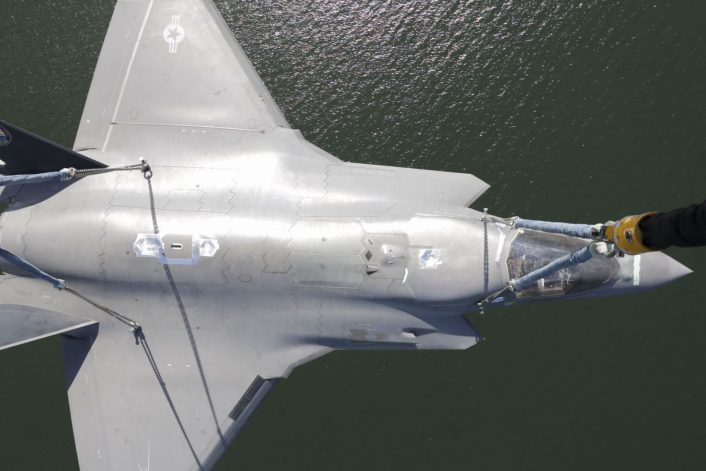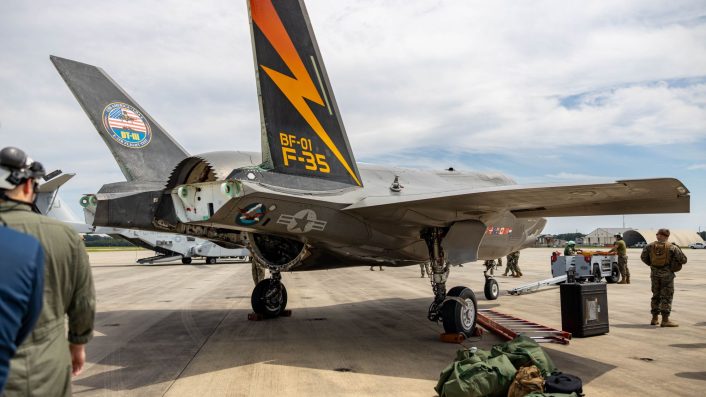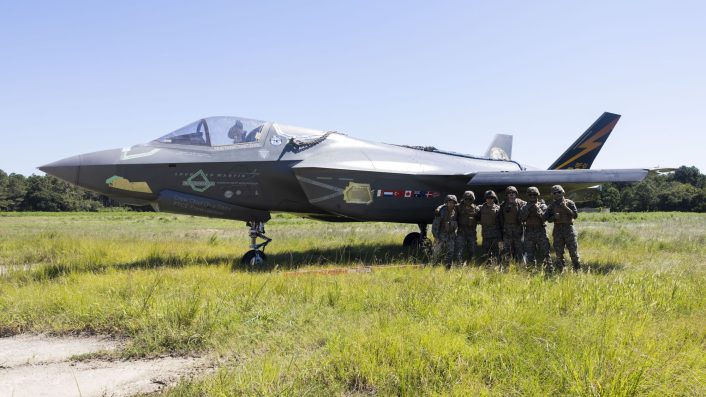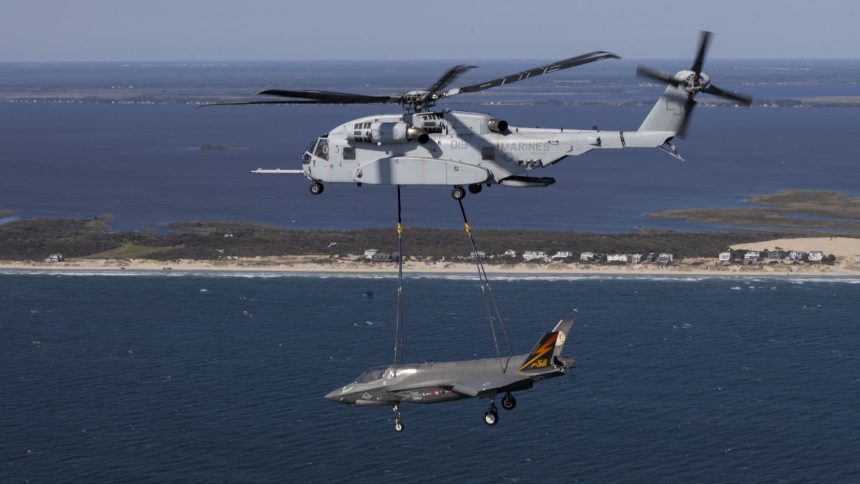Airframe BF-01 performed the F-35’s first vertical landing on Mar. 18, 2010, and the first vertical takeoff on May 10, 2013, at NAS Patuxent River.
The first F-35B Lightning II STOVL (Short Take-Off Vertical Landing) jet to be built, and which performed the type’s first vertical take off and landing, was transported by a U.S. Marine Corps CH-53K King Stallion heavy lift helicopter to MCAS Beaufort, South Carolina, on Aug. 27, 2025. The aircraft will be retired there as a static display.
Classified as a flight sciences test aircraft, airframe “BF-01” flew for the first time on Jun. 11, 2008, later conducting the F-35B’s first vertical landing (VL) at Pax River on Mar. 10, 2010. Three years later, on May 13, 2013, BF-01 performed the F-35B’s first vertical take-off (VTO) as part of its 286th flight, again at Pax River.
BF-01 was carried as a sling load by the CH-53K from NAS (Naval Air Station) Patuxent River, Maryland, to MCAS Beaufort in the 552 mile (888 km) journey southwards. The CH-53K, assigned to HMH (Heavy Helicopter Squadron) 461,, was supported by another King Stallion in the Air Delivered Ground Refueling (ADGR) role.
#Marines with Marine Aircraft Group 29, 2nd Marine Aircraft Wing, transport an F-35B Lightning II near Naval Air Station Patuxent River, Maryland.
The F-35, known as BF-1, was the first F-35 to perform a vertical landing and was transported to Marine Corps Air Station Beaufort,… pic.twitter.com/zDHwq364yy
— U.S. Marines (@USMC) August 28, 2025
The squadron, part of the MAG 29 (Marine Aircraft Group 29) within the 2nd MAW (2nd Marine Aircraft Wing), rehearsed the entire long-range external lift operation a day prior at NAS Patuxent River. BF-01, was completely demilitarized with the engine and horizontal stabilizers removed, and the door covering the vertical lift fan sealed, images released on DVIDS showed.
First F-35B retires
The Department of Defense said on Instagram that BF-1’s permanent static display “will inspire future generations of aviators.” MCAS Beaufort said in its own post it was proud to receive the first F-35B “ushering in a new era for Marine Corps Aviation.”
“BF-01 ended its career by making its way to the air station in a historic heavy-lift mission, and will stand as a tribute to Marine aviation’s past, present, and future,” the base added.
During the May 20, 2013 first VTO, Lockheed Martin said: “While not a capability used in combat, VTOs are required for repositioning of the STOVL in environments where a jet could not perform a short takeoff. In these cases, the jet, with a limited amount of fuel, would execute a VTO to travel a short distance.”
The aircraft was also involved in the Developmental Testing phase II (DT-II) on the USS Wasp (LHD 1) in 2016. BF-01 was finally retired in 2022, with thousands of flight hours in the logs.
The mission
The press release from NAVAIR (Naval Air Systems Command) said that the F-35B, “without its mission and propulsion systems, outer wings, or additional equipment,” will be used as a permanent static display at MCAS Beaufort. HMH-461 commanding officer Col. Matthew Bagley praised the unit’s professionalism, commitment, and capability while also crediting the coordination between organizations which made the mission a success.
“As extraordinary as it may have seemed, this was just another day for the squadron,” Bagley said. Program manager for the CH-53 Heavy Lift Helicopters Program Office (PMA-261) Col. Kate Fleeger said the CH-53K lifted the 22,000 pound F-35B with “ample power margin and range, underscoring how the platform provides unmatched support to joint operations.”
“Although the helicopter only reached IOC (Initial Operational Capability) in Apr. 2022, the King Stallion has already been used multiple times to execute its Tactical Recovery of Aircraft and Personnel (TRAP) mission,” further added Fleeger.
View this post on Instagram
“The CH-53K is not merely an upgrade of the CH-53E,” said Bagley in the press release. “It represents a fundamental shift in how Marine Heavy Helicopter Squadrons can enable warfighting concepts like distributed aviation operations and maritime operations in a contested environment.” He added that the squadron is “ready and eager for the opportunity to provide this critical capability wherever it is needed most.”
The Corps appears to be favoring the carrier-launched F-35C over the F-35B. In 2022, the Corps’ Lightning II acquisition plans included 353 F-35Bs and 67 F-35C Carrier Variant (CV) jets, for a total of 420 aircraft to be received at a rate of roughly 20 per year.
However, the MAP (Marine Aviation Plan) released in February 2025, as per reports, reduced the F-35B’s number to 280 and raised the F-35C’s inventory to 140, while retaining the total fleet number to 420 airframes.

Previous F-35 ‘lifts’ by CH-53K
This is not the first time a CH-53K King Stallion has carried an F-35 as an external load. On Dec. 13, 2022, a King Stallion conducted its first “external load certification testing lift” at NAS Patuxent River by carrying a non-flyable F-35C, CF-1, “to evaluate the load and inform future lift capabilities,” and generate data from the “sling configuration analysis and cargo characteristics.”
The F-35 Integrated Test Force at NAS Pax River (Pax River ITF), Naval Air Warfare Center Aircraft Division (NAWCAD) Cargo Lab and Marine Operational Test and Evaluation Squadron One (VMX-1) collaborated in the effort.
CF-1, a developmental test carrier variant F-35C, had accrued 750 flight hours in 450 test flights between 2010 and 2016. The F-35C and rigging weighed about 22,000 pounds after removal of its mission and propulsion systems, outer wings, and additional equipment.

Then, on Apr. 24, 2024, CF-1 was again lifted by a CH-53K King Stallion from VMX-1 from Pax River ITF to the NAWCAD’s PMT (Prototype, Manufacturing and Test) facility at Joint Base McGuire-Dix-Lakehurst, New Jersey. The CH-53K was also refueled mid-flight by a KC-130T with the F-35C (CF-1) suspended underneath.
The CH-53K conducted its first operational mission in September 2021, when it lifted a Navy MH-60S Knighthawk helicopter from a 12,000-foot mountain top in California. That aircraft weighed approximately 15,000 pounds and was successfully transported for 23 miles to Fallon, Nevada.

The CH-53K is currently cleared to conduct a 27,000-pound external lift and is projected to be cleared for a 36,000-pound external lift under high, hot conditions, nearly three times more than its notoriously problem-ridden predecessor, the CH-53E Super Stallion.
The King Stallion features a full-glass cockpit and digital-fly-by-wire flight control system easing pilot workload; three General Electric T408 turbofans generating 50% more power; an all-new transmission and rotor assembly; redesigned gearboxes correcting the design flaws in the ones on the Super Stallion; improved, more efficient blades; and 63% fewer parts than than the CH-53E.
The U.S. Marine Corps started a phased transition from the CH-53E King Stallion to the CH-53K Super Stallion in 2019-2020 for all its six heavy lift squadrons operating at least 16 helicopters – a process that will continue well into the 2030s. Speaking at the Helicopter Technology Central and Eastern Europe conference on May 22, PMA-261’s Maj. Joshua Banks said that no squadron will simultaneously operate the CH-53E and ‘K’ variants, and a unit undergoing conversion will not deploy during that period.









